Kruger National Park
Kruger National Park is a South African National Park and one of the largest game reserves in Africa. It covers an area of 19,485 km2 (7,523 sq mi) in the provinces of Limpopo and Mpumalanga in northeastern South Africa, and extends 360 km (220 mi) from north to south and 65 km (40 mi) from east to west. The administrative headquarters are in Skukuza. Areas of the park were first protected by the government of the South African Republic in 1898, and it became South Africa's first national park in 1926.
| Kruger National Park | |
|---|---|
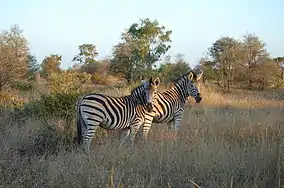 Burchell's zebra in a Kruger landscape | |
 Location of the park (red area) in South Africa | |
| Location | Limpopo and Mpumalanga provinces, South Africa |
| Nearest city | Mbombela (southern) Phalaborwa (central) |
| Coordinates | 24°0′41″S 31°29′7″E |
| Area | 19,485 km2 (7,523 sq mi)[1][2][3] |
| Established | 31 May 1926[4][5](1898) |
| Visitors | 1,659,793 (1,277,397 day visitors, 382,396 overnight)[6] (in 2014-15 financial year) |
| Governing body | South African National Parks |
| www | |
| Wikivoyage has a travel guide for Kruger National Park. |
To the west and south of the Kruger National Park are the two South African provinces of Limpopo and Mpumalanga, respectively. To the north is Zimbabwe, and to the east is Mozambique. It is now part of the Great Limpopo Transfrontier Park, a peace park that links Kruger National Park with the Gonarezhou National Park in Zimbabwe, and with the Limpopo National Park in Mozambique.
The park is part of the Kruger to Canyons Biosphere, an area designated by the United Nations Educational, Scientific and Cultural Organization (UNESCO) as an International Man and Biosphere Reserve.[7]
The park has nine main gates allowing entrance to the different camps.
History
Pre-reserve (prior to 1898)
Over 420 recorded archaeological sites in Kruger Park attest to its occupation before modern times. Most sites however had relatively short occupation periods, as the presence of predators and the tsetse fly limited cattle husbandry. At Masorini hill, beside the H9 route, iron smelting was practiced up to the Mfecane era. The reconstructed Thulamela on a hilltop south of the Levuvhu River was occupied from the 13th to 16th centuries, and had links with traders from the African east coast.
Before the Second Anglo-Boer War, the area now covered by the park was a remote section of the eastern South African Republic's last wild frontier. Paul Kruger, President of the South African Republic at the time, proclaimed the area, which was inhabited by the Tsonga people, a sanctuary for the protection of its wildlife. James Stevenson Hamilton noted many kraals along the Sabi River and also further north beyond the Letaba River[8] although the north was sparsely populated compared to the south. Many of the local natives were employed by railway companies for construction of rail connections, notably that between Pretoria (now in South Africa) and Lorenço Marques (now Maputo, Mozambique) during the end of the 19th century. Abel Chapman, one of the hunters who noted that the area was over-hunted by the end of the 19th century, brought this fact to wider attention.
Sabi Game Reserve (1898–1926)
In 1895, Jakob Louis van Wyk introduced in the Volksraad of the old South African Republic a motion to create the game reserve. The area proposed extended from the Crocodile River to the Sabi River in the north. That motion, introduced together with another Volksraad member by the name of R. K. Loveday, and accepted for discussion in September 1895 by a majority of one vote, resulted in the proclamation by Paul Kruger, on 26 March 1898, of a "Government Wildlife Park." This park would later be known as the Sabi Game Reserve.
The park was initially created to control hunting,[9] and to protect the diminished number of animals in the park.
James Stevenson-Hamilton became the first warden of the reserve in 1902.[9] The reserve was located in the southern one-third of the modern park.[10] Singwitsi Reserve, named after the Shingwedzi River and now in northern Kruger National Park, was proclaimed in 1903.[11] During the following decades all the native tribes were removed from the reserve and during the 1960s the last were removed at Makuleke in the Pafuri triangle. In 1926, Sabie Game Reserve, the adjacent Shingwedzi Game Reserve, and farms were combined to create Kruger National Park.[12]
During 1923, the first large groups of tourists started visiting the Sabie Game Reserve, but only as part of the South African Railways' popular "Round in Nine" tours. The tourist trains used the Selati railway line between Komatipoort on the Mozambican border and Tzaneen in Limpopo Province. The tour included an overnight stop at Sabie Bridge (now Skukuza) and a short walk, escorted by armed rangers, into the bush. It soon became a highlight of the tour and it gave valuable support for the campaign to proclaim the Sabie Game Reserve as a national park.[13][14]
Kruger National Park (1926–1946)
After the proclamation of the Kruger National Park in 1926, the first three tourist cars entered the park in 1927, jumping to 180 cars in 1928 and 850 cars in 1929.[5]
Warden James Stevenson-Hamilton retired on 30 April 1946, after 44 years as warden of the Kruger Park and its predecessor, the Sabi Sabi Game Reserve.
1946–1994
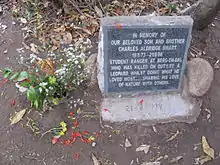
Stevenson-Hamilton was replaced as warden by Colonel J. A. B. Sandenbergh of the South African Air Force.[13] During 1959, work commenced to completely fence the park's boundaries. Work started on the southern boundary along the Crocodile River and in 1960 the western and northern boundaries were fenced, followed by the eastern boundary with Mozambique. The purpose of the fence was to curb the spread of diseases, facilitate border patrolling and inhibit the movement of poachers.[13]
The Makuleke area in the northern part of the park was forcibly taken from the Makuleke people by the government in 1969 and about 1500 of them were relocated to land to the south so that their original tribal areas could be integrated into the greater Kruger National Park.[15][16]
1994–present

In 1996 the Makuleke tribe submitted a land claim for 19,842 hectares (198.42 km2), namely the Pafuri or Makuleke region in the northernmost part of the park.[17] The land was given back to the Makuleke people, however, they chose not to resettle on the land but to engage with the private sector to invest in tourism. This resulted in the building of several game lodges from which they earn royalties.[18][19]
In the late 1990s, the fences between the Kruger Park and Klaserie Game Reserve, Olifants Game Reserve and Balule Game Reserve were dropped and incorporated into the Greater Kruger Park with 400,000 hectares added to the Reserve. In 2002, Kruger National Park, Gonarezhou National Park in Zimbabwe, and Limpopo National Park in Mozambique were incorporated into a peace park, the Great Limpopo Transfrontier Park.[12]
In 2009, SANParks envisaged a four-star hotel northeast of Malelane on the bank of the Crocodile River, as part of a survival strategy to make the park less dependent on state subsidies.[20] Eventually Radisson Blu was mandated to operate a 104-room safari resort starting 2019,[21][22] which promises a smaller ecological footprint than that of prior, existing camps. The three-star, 128-room Skukuza Safari Lodge, to be completed by late 2018,[23] was necessitated by the adjacent Nombolo Mdhluli conference center, opened in 2011, which draws guests arriving by charter flights or in tour busses.[23] Former head of the park Salomon Joubert warned that these developments threaten the character, ethos and original objectives of the park,[20] but minister of environmental affairs, Edna Molewa, deemed development of 0.3% of the park as acceptable.[23] The park was temporarily closed due to the COVID-19 pandemic on 25 March 2020. It was reopened on 08 June 2020 for local self drive business only and remains like that until the pandemic abates.[24]
Location and geography
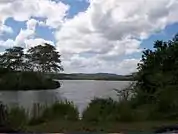
The park lies in the north-east of South Africa,[10] in the eastern parts of Limpopo and Mpumalanga provinces. Phalaborwa, Limpopo is the only town in South Africa that borders the Kruger National Park. It is one of the largest national parks in the world, with an area of 19,485 km2 (7,523 sq mi). The park is approximately 360 km (220 mi) long,[10] and has an average width of 65 km (40 mi).[12] At its widest point, the park is 90 km (56 mi) wide from east to west.[10] To the north and south of the park two rivers, the Limpopo and the Crocodile respectively, act as its natural boundaries. To the east the Lebombo Mountains separate it from Mozambique. Its western boundary runs parallel with this range, roughly 65 km (40 mi) distant. The park varies in altitude between 200 m (660 ft) in the east and 840 m (2,760 ft) in the south-west near Berg-en-Dal. The highest point in the park is here, a hill called Khandzalive. Several rivers run through the park from west to east, including the Sabie, Olifants, Crocodile, Letaba, Luvuvhu and Limpopo Rivers.
Climate
The climate of the Kruger National Park and lowveld is subtropical/tropical, specifically a hot semi-arid climate (Köppen BSh). Summer days are humid and hot. The rainy season is from September until May. The Kruger National Park website lists September and October as the driest periods, culminating in the beginning of the rainy season late in October. Because the park spans 360 kilometres or 220 miles from north to south, climate can vary throughout the park. Skukuza in the southern part of the park is about 2 to 3 °C (3.6 to 5.4 °F) cooler throughout the year than Pafuri in the north, with significantly more rainfall.
| Climate data for Skukuza, 1961-1990 | |||||||||||||
|---|---|---|---|---|---|---|---|---|---|---|---|---|---|
| Month | Jan | Feb | Mar | Apr | May | Jun | Jul | Aug | Sep | Oct | Nov | Dec | Year |
| Record high °C (°F) | 43 (109) |
43 (109) |
42 (108) |
40 (104) |
38 (100) |
35 (95) |
36 (97) |
38 (100) |
42 (108) |
44 (111) |
43 (109) |
42 (108) |
44 (111) |
| Average high °C (°F) | 33 (91) |
32 (90) |
31 (88) |
29 (84) |
28 (82) |
26 (79) |
26 (79) |
27 (81) |
29 (84) |
30 (86) |
31 (88) |
32 (90) |
30 (86) |
| Average low °C (°F) | 21 (70) |
20 (68) |
19 (66) |
15 (59) |
10 (50) |
6 (43) |
6 (43) |
9 (48) |
13 (55) |
16 (61) |
18 (64) |
20 (68) |
14 (57) |
| Record low °C (°F) | 11 (52) |
10 (50) |
8 (46) |
6 (43) |
1 (34) |
−4 (25) |
−4 (25) |
−4 (25) |
1 (34) |
6 (43) |
10 (50) |
10 (50) |
−4 (25) |
| Average precipitation mm (inches) | 94 (3.7) |
96 (3.8) |
66 (2.6) |
38 (1.5) |
14 (0.6) |
11 (0.4) |
11 (0.4) |
8 (0.3) |
28 (1.1) |
40 (1.6) |
63 (2.5) |
92 (3.6) |
561 (22.1) |
| Average precipitation days (≥ 1 mm) | 9 | 9 | 9 | 6 | 3 | 2 | 2 | 2 | 3 | 7 | 10 | 10 | 71 |
| Source: SAWS[25] | |||||||||||||
| Climate data for Phalaborwa | |||||||||||||
|---|---|---|---|---|---|---|---|---|---|---|---|---|---|
| Month | Jan | Feb | Mar | Apr | May | Jun | Jul | Aug | Sep | Oct | Nov | Dec | Year |
| Average high °C (°F) | 34 (93) |
33 (91) |
32 (90) |
30 (86) |
29 (84) |
27 (81) |
26 (79) |
28 (82) |
31 (88) |
32 (90) |
32 (90) |
33 (91) |
33 (91) |
| Daily mean °C (°F) | 26.5 (79.7) |
26 (79) |
25 (77) |
23 (73) |
20 (68) |
18 (64) |
17.5 (63.5) |
19 (66) |
22 (72) |
23 (73) |
24 (75) |
26 (79) |
22 (72) |
| Average low °C (°F) | 21 (70) |
21 (70) |
20 (68) |
17 (63) |
12 (54) |
10 (50) |
9 (48) |
11 (52) |
14 (57) |
17 (63) |
19 (66) |
21 (70) |
16 (61) |
| Average precipitation mm (inches) | 97 (3.8) |
81 (3.2) |
65 (2.6) |
25 (1.0) |
12 (0.5) |
4 (0.2) |
7.5 (0.30) |
7 (0.3) |
21 (0.8) |
46 (1.8) |
69 (2.7) |
96 (3.8) |
529 (20.8) |
| Source: [26] | |||||||||||||
| Climate data for Pafuri Rest camp, Kruger National Park | |||||||||||||
|---|---|---|---|---|---|---|---|---|---|---|---|---|---|
| Month | Jan | Feb | Mar | Apr | May | Jun | Jul | Aug | Sep | Oct | Nov | Dec | Year |
| Average high °C (°F) | 35 (95) |
34 (93) |
33.6 (92.5) |
32.7 (90.9) |
29.9 (85.8) |
27.7 (81.9) |
28 (82) |
29.9 (85.8) |
32.1 (89.8) |
34.7 (94.5) |
34.1 (93.4) |
35.1 (95.2) |
32.2 (90.0) |
| Daily mean °C (°F) | 28.2 (82.8) |
28 (82) |
26.9 (80.4) |
25.4 (77.7) |
21.7 (71.1) |
18.9 (66.0) |
19 (66) |
20.9 (69.6) |
23.8 (74.8) |
26.9 (80.4) |
27.2 (81.0) |
28.2 (82.8) |
24.6 (76.2) |
| Average low °C (°F) | 21.5 (70.7) |
22 (72) |
20.3 (68.5) |
18.1 (64.6) |
13.6 (56.5) |
10.2 (50.4) |
10 (50) |
12 (54) |
15.6 (60.1) |
19.1 (66.4) |
20.4 (68.7) |
21.4 (70.5) |
17.0 (62.7) |
| Average precipitation mm (inches) | 90 (3.5) |
77 (3.0) |
36 (1.4) |
22 (0.9) |
10 (0.4) |
5 (0.2) |
2 (0.1) |
2 (0.1) |
10 (0.4) |
17 (0.7) |
54 (2.1) |
86 (3.4) |
411 (16.2) |
| Source: [27] | |||||||||||||
Flora and fauna
Vegetation
Plant life consists of four main areas, which correspond roughly to the four quadrants of the park. The main veld types are determined by the rainfall gradient and geological substrates.
Shrub mopane veld
Shrub mopane covers almost the entire north-eastern part of the park.
Red bush-willow and mopane veld
This area lies in the western half of the park, north of the Olifants River. The two most prominent species here are the red bush-willow (Combretum apiculatum) and the mopane tree (Colophospermum mopane).
Thorn trees and red bush-willow veld
This area lies between the western boundary and roughly the centre of the park south of the Olifants River. Combretums, such as the red bush-willow (Combretum apiculatum), and Acacia species predominate while there are a great number of marula trees (Sclerocarya caffra). The Acacias are dominant along the rivers and streams, the very dense Nwatimhiri bush along the Sabie River between Skukuza and Lower Sabie being a very good example.
Knob-thorn and marula veld
South of the Olifants River in the eastern half of the park, this area provides the most important grazing-land. Species such as red grass (Themeda triandra) and buffalo grass (Panicum maximum) predominate while the knob-thorn (Acacia nigrescens), leadwood (Combretum imberbe) and marula (Sclerocarya caffra) are the main tree species.
Local vegetation communities
There are a number of smaller areas in the park which carry distinctive vegetation. The Pretoriuskop sourveld and Malelane mountain bushveld receive relatively high rainfall. Here sickle bush and silver cluster-leaf (Terminalia sericea) are prominent. The sandveld communities northeast of Punda Maria are equally distinctive, with a wide variety of unique plant species. The bush-clad hills along the Levuvhu River also shelter an interesting floral diversity and some near-endemic species.
Mammals
_(30941994012).jpg.webp)
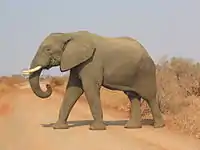
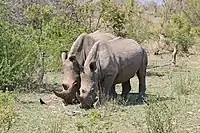
All the big five game animals are found at Kruger National Park, which has more species of large mammals than any other African game reserve (at 147 species). There are webcams set up to observe the wildlife.[29]
The park stopped culling elephants in 1994 and tried translocating them, but by 2004 the population had increased to 11,670 elephants, by 2006 to approximately 13,500, by 2009 to 11,672, and by 2012 to 16,900. The park's habitats may only be able to sustain about 8,000 elephants, though this is not entirely clear. Elephants do change plant growth and density in the park, and some species, such as wildebeests, clearly benefit from an increase in grasslands. The park started an attempt at using contraception in 1995, but has stopped that due to problems with delivering the contraceptives and upsetting the herds.
Kruger supports packs of the endangered African wild dog, of which there are thought to be only about 400 in the whole of South Africa.[30]
| Species | Count (2009) | Count (2010)[31] | Count (2011)[32] |
|---|---|---|---|
| Black rhinoceros | 350 | 590–660 | – |
| Blue wildebeest | 9,612 | 11,500 | 6,400–13,100 |
| Plains zebra | 17,797 | 26,500 | 23,700–35,300 |
| Bushbuck | 500 | 500 | – |
| African buffalo | 27,000 | 37,500 | 37,130 |
| Common eland | 300 | 460 | 460 |
| African bush elephant | 11,672 | 13,700 | 13,750 |
| Giraffe | 5,114 | 9,000 | 6,800–10,300 |
| Greater kudu | 5,798 | 9,500 | 11,200–17,300 |
| Hippopotamus | 3,000 | 3,100 | 3,100 |
| Impala | 150,000 | 120,000 | 132,300–176,400 |
| Hartebeest | – | 50 | – |
| Mountain reedbuck | – | 150 | 150 |
| Nyala | – | 300 | 300 |
| Roan antelope | – | 90 | 90 |
| Sable antelope | – | 290 | 290 |
| Common warthog | – | 3,500 | 3,100–5,700 |
| Waterbuck | 5,000 | 5,500 | 3,100–7,800 |
| White rhinoceros | 7,000 to 12,000[33] | 10,500 | – |
| African wild dog | 240 | – | 120 |
| Cheetah | 120 | 120 | 120 |
| Nile crocodile | – | 4,420 | 4,420 |
| Leopard | 2,000 | 1,000 | 1,000 |
| Lion | 2,800 | 1,600 | 1,620–1,720 |
| Spotted hyena | 2,000 | 3,500 | 5,340 |
Birds
Out of the 517 species of birds found at Kruger, 253 are residents, 117 non-breeding migrants, and 147 nomads. Some of the larger birds require large territories or are sensitive to habitat degradation. Six of these species, which are by and large restricted to Kruger and other extensive conservation areas, have been assigned to a fanciful grouping called the "Big Six Birds".[34] They are the lappet-faced vulture, martial eagle, saddle-billed stork, kori bustard, ground hornbill and the reclusive Pel's fishing owl, which is localized and seldom seen. The 2011 aerial survey found 22 martial eagle nest sites, the 2015 survey an additional 17, while the 2020 survey found 70 nest locations in all,[35] though the activity of these has yet to be determined. There are 25 to 30 breeding pairs of saddle-billed stork in the park, besides a handful of non-breeding individuals.[34] In 2012 178 family groups of ground hornbills roamed the park and 78 nests were known, of which 50% were active.[36]
Other vertebrates
Kruger is inhabited by 126 species[37] of reptile, including black mambas, African rock pythons, and 3,000 Nile crocodiles. As yet, knowledge of the densities and distributions of the reptiles, especially on smaller spatial scales, is limited by sampling bias and a strong dependence on the park's public infrastructure is evident.[37] Thirty-three species of amphibians are found in the Park,[38] as well as 50 fish species. A Zambesi shark, Carcharhinus leucas, also known as the bull shark, was caught at the confluence of the Limpopo and Luvuvhu Rivers in July 1950. Zambezi sharks tolerate fresh water and can travel far up rivers like the Limpopo.[39]
Invertebrates
219 species of butterfly and skipper are native to the park.[40] The fastest and most robust of these belong to the genus Charaxes,[41] of which 12 species have been recorded.[42] Genera Papilio and Acraea are also well-represented, with about 10 and 15 species respectively.[42] The total number of Lepidoptera species in the park is unknown, but could be in the order of 7,000, many of which range widely in African savanna. The mopane moth in the northern half of the park is one of the best known, and communities outside the park have at times been given permits to harvest their caterpillars.[43][44][45] The park has a high diversity of termites and 22 genera are known to occur, including the mound-building genera Macrotermes, Cubitermes, Amitermes, Odontotermes and Trinervitermes.[46] A new species of woodlouse, Ctenorillo meyeri, has been discovered inside termite nests, east of Phalaborwa and near Mopani Rest Camp.[47] It is the first instance of a termitophilous species from the family Armadillidae. Many species of mosquito occur in the park, including the Culex, Aedes and Anopheles genera which target mammals. A. arabiensis is the most prevalent of the 9 or more Anopheles species in the park, and their females transmit malaria.[48] As of 2018, 350 species of arachnids, excluding ticks and mites, are known from Kruger.[49] These are mostly true spiders, including 7 species of baboon spider, but also 9 scorpion and 7 pseudoscorpion species, 18 solifugid species (sun and roman spiders), 2 species of harvestmen and 1 species of tailless whip scorpion.[50]
Threats
The park's ecosystem is subject to several threats, including intensive poaching, urban development at its borders,[51] global warming and droughts,[52] animal overpopulation,[53] and mining projects.[54]
Light pollution produced by rest camps and nearby towns affects the biodiversity of Kruger National Park. In particular, it alters the composition of nocturnal wildlife and the hunting behaviour of predators.[55]
Anti-poaching measures
Kruger is not exempt from the threat of poaching that many other African countries have faced. Many poachers are in search of ivory from elephant tusks or rhino horns, which are similar in composition to human fingernails.[56] The park's anti-poaching unit consists of 650[57] SANParks game rangers, assisted by the SAPS and the SANDF (including the SAAF). As of 2013, the park is equipped with two drones borrowed from Denel and two Aérospatiale Gazelle helicopters, donated by the RAF to augment its air space presence.[58][59] Automated movement sensors relay intrusions along the Mozambique border to a control center,[60] and a specialist dog unit has been introduced.[61] Buffer zones have been established along the border with Mozambique,[62] from where many poachers have infiltrated the park, as an alternative to costly new fences.[63] The original 150 km long fences were dropped in 2002 to establish the Great Limpopo Transfrontier Park.[57][64] The national anti-poaching committee oversees all activities and coordinates interested parties.[65][66]
Poachers
Kruger's big game poachers operate with night vision instruments and large caliber rifles, fitted with suppressors and sophisticated telescopic sights.[67][68] They are mostly Mozambique citizens that initiate their carefully planned incursions from the border region of South Africa and Mozambique.[67][69][70] In 2012 some 200 poachers were apprehended,[71] while about 30 were killed in skirmishes.[72][73]
In July 2012, a Kruger game ranger and policeman were the first to die in an anti-poaching operation,[74] while other employees reported intimidation by poachers.[75][76][77][78] A Kruger personnel strike affected some anti-poaching operations,[79] and some employees have been directly implicated.[75][80][81][82][83][84] Rangers in and around the park have been pressured or blackmailed by poaching syndicates to provide intelligence on the whereabouts of rhinos and anti-poaching operations.[85]
In December 2012, Kruger started using a Seeker II drone against rhino poachers. The drone was loaned to the South African National Parks authority by its manufacturer Denel Dynamics, South Africa.[86][87]
In June 2019, a Helix surveillance aircraft system was deployed on night missions in the park, and apprehended half a dozen suspected poachers.[88]
Other threats to poachers include the dangerous nature of the park itself. In February 2018, a poacher was believed to have been trampled by elephants and then eaten by lions, leaving rangers to later find only a human skull and a pair of trousers, alongside a loaded hunting rifle.[89][90]
Rhino
Poachers make no distinction between white and black rhinos,[76][91] but losses of black rhinos are low due to their reclusive and aggressive nature.[92] Rhino horn fetches between $66,000 and $82,000 per kilogram,[70][77][92][93][94] and the CITES ban has proved largely ineffectual against the trade in rhino horn.[95][96] The second horn is sometimes also hacked from the skull to obtain about 100 ml of moisture that is sold locally as traditional medicine.[92]
Poaching rhino horn escalated in the 21st century, with 949 rhinos killed in Kruger in the first 12 years,[58] and more than 520 in 2013 alone.[97][98] A memorandum of agreement is seen as a necessary milestone in stemming the tide between South Africa and Vietnam, in addition to the one with China,[63][99][100] while negotiations have not yet started with Thailand.[101] The amount of rhino horn held in storage is not publicly known.[102] Since 2009, some Kruger rhinos have been fitted with invisible tracing devices in their bodies and horns which enable officials to locate their carcasses and to track the smuggled horns by satellite.[103] South Africa's 22,000 white and black rhinos represent some 93% of these species' world population, 12,000 of which are found in Kruger.[76][96]
Elephant
Kruger experienced significant elephant poaching in the 1980s.[103] Due to international and national efforts, including a worldwide ban on ivory sales beginning in 1989, the poaching was abated for many years, but a sharp rise in 2014 has continued and the numbers of elephants poached per year in the park is growing at an alarming rate.[104][105]
Following approval by CITES, 47 metric tons of stockpiled ivory from Kruger was auctioned on 6 November 2008. The sale fetched approximately US$6.7 million which was allocated to increased anti-poaching measures. The intention was to flood the market, crash prices and make poaching less profitable. But instead, the legal sale was followed by “an abrupt, significant, permanent, robust and geographically widespread increase” in elephant poaching, as subsequent research showed.[106][107]
The latest Convention on the International Trade in Endangered Species of Wild Flora and Fauna (CITES), summit voted down proposals for further one-off ivory sales from stockpiles for having led to increases in poaching across the continent.[108][109] Across the continent the African elephant population decreased 30% in the period between 2007-2014. [110][111]
Other
It is foreseen that the placement of wire traps to procure meat would eventually become the most challenging form of poaching.[112] A scheme has been proposed to reward adjacent communities with the proceeds of game sales in return for their cooperation in game preservation.[112] The larger communities include Bosbokrand, Acornhoek, Hazyview, Hoedspruit, Komatipoort, Malelane, Marloth Park, Nelspr v v v v v vuit and Phalaborwa.[96] Communities along the northern boundary have complained about a number of issues that affect them, including livestock killed by escaped predators.[113]
Rest camps
Kruger Park contains twelve main rest camps, as well as several smaller camps scattered throughout the park.[114] There are also several concessions licensed to private companies with their own camps.[115]
The main camps in the park are larger camps containing shops, restaurants or cafeterias, petrol stations and first aid stations. The largest camp, which also serves as the headquarters for Kruger, is Skukuza.
Skukuza
.jpg.webp)
Skukuza is the biggest camp in Kruger, as it also contains the administrative headquarters for the park. It is located on the southern bank of the Sabie River 12 km Paul Kruger Gate and 39 km from Phabeni gate.[116] In addition to accommodations, Skukuza contains a conference centre and is a short drive from Skukuza Airport, the only commercial airport in the park.
Berg-en-Dal
Berg-en-Dal is one of the most accessible camps in Kruger. It is 12 km from Malelane Gate, which is an hour drive from Nelspruit via the N4.[117] The camp contains 69 bungalows which sleep 2-3, 23 family cottages with multiple bedrooms that sleep 4-6, 2 guest houses, and 72 camping or caravan sites.[118] Running along much of the boundary of the camp is the Rhino Trail, a walking trail which takes about an hour to complete. The camp also contains several overlooks and a swimming pool.[119]
Malelane
Near Berg-en-Dal and the Malelane gate is the small Malelane satellite camp. Featuring 15 tent sites, 4 four-bed rondavels and 1 three-bed rondavel, Malelane only provides one activity of game drives.[120] Check-in is handled through Malelane Gate.[121]
Crocodile Bridge
Crocodile Bridge is directly along the southern border of the park near the town of Komatipoort. It is smaller than the other main camps, and as such doesn't have a separate restaurant. The camp also has easy access to the Mozambican border just on the other side of Komatipoort.
Letaba
.jpg.webp)
Letaba rest camp overlooks a bend in the Letaba River, very close to the geographic centre of the park. Its accommodations include 86 rondavels, 20 furnished tents, 10 six-bed cottages, 5 three-bed huts with communal ablutions, 60 tent or caravan sites, and two large guest houses, the Melville and the Fish Eagle. The Fish Eagle guest house also contains a private bird hide. Letaba also hosts the Elephant Hall, a small museum dedicated to elephants, especially the Magnificent Seven.
Lower Sabie
Lower Sabie lies about 45 km downstream of Skukuza on the south bank of the Sabie River. It is situated near one of the three bridges to cross the Sabie river in the park (both of the others being near Skukuza). Because of its location, it has large amounts of water, flat plains, and hills easily accessible from the camp.[122]
Mopani
Mopani sits on the north bank of Pioneer Dam, just south of the Tropic of Capricorn and 50 km north of Letaba. Mopani is also the administrative location of the Shipandani sleep-over bird hide, a hide which can be booked for overnight stays for 2-6 people.
Other camps
.jpg.webp)
The other main camps are:[114]
- Olifants and its satellite camp Balule
- Orpen and its satellite camps Maroela and Tamboti
- Pretoriuskop
- Punda Maria
- Satara
- Shingwedzi
South African National Parks also manages several bushveld camps: Bataleur, Biyamiti, Shimuwini, Sirheni and Talamati. Additionally, two overnight hides, Sable Hide and Shipandani Sleepover Hide, can be booked. Several private lodges, including some luxury lodges, are also scattered throughout the park.
Gates to the Kruger Park
Kruger National Park
.jpg.webp)
(northernmost entrance to the park)
.jpg.webp)
(a southern entrance to the park)

The Kruger Park has the following gates:
| Name | Road | From Town | Coordinates |
|---|---|---|---|
| Crocodile Bridge Gate | on the extension of Rissikstreet | from Komatipoort | 25°21′30″S 31°53′37″E |
| Malelane Gate | on the R570 off the N4 | near Malelane | 25°27′43″S 31°31′59″E |
| Numbi Gate | on the R569 road | from Hazyview | 25°9′19″S 31°11′51″E |
| Phabeni Gate | on the road off the R536 | from Hazyview | 25°01′30″S 31°14′29″E |
| Paul Kruger Gate | on the R536 road | from Hazyview | 24°58′53″S 31°29′7″E |
| Orpen Gate | on the R531 road | from Klaserie | 24°28′33″S 31°23′27″E |
| Phalaborwa Gate | on the R71 road | from Phalaborwa | 23°56′44″S 31°9′54″E |
| Punda Maria Gate | on the R524 road | from Thohoyandou | 22°44′18″S 31°0′33″E |
| Pafuri Gate | on the R525 road | from Musina | 22°24′1″S 31°2′29″E |
Wilderness trails
Nine different trails are on offer in the Kruger National Park.[123] Some are overnight and they last several days in areas of wilderness virtually untouched by humans. There are no set trails in the wilderness areas; a visitor walks along paths made by animals or seeks out new routes through the bush.
Gallery
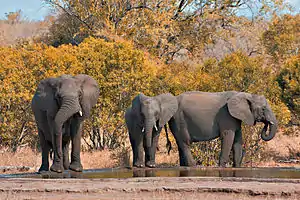 Elephant family at an artificial water hole
Elephant family at an artificial water hole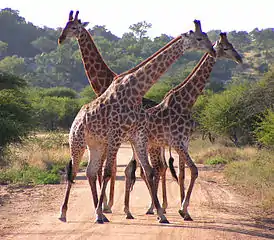
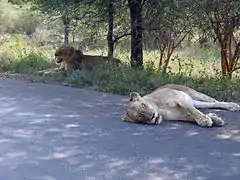 Two lionesses having a break after an unsuccessful hunt
Two lionesses having a break after an unsuccessful hunt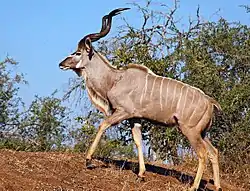 A greater kudu bull
A greater kudu bull
See also
References
- Rob East, ed. (1989). "Chapter 10: South Africa". Antelopes: Southern and South-Central Africa Pt. 2: Global Survey and Regional Action Plans. International Union for Conservation of Nature and Natural Resources, roughly the Size of Wales. Antelope Specialist Group. p. 60. ISBN 978-2-88032-970-9.
- Merriam Webster's Collegiate Encyclopedia. Merriam-Webster. January 2001. p. 902. ISBN 978-0-87779-017-4.
- "The Official SADC Trade, Industry and Investment Review 2006" (PDF). Southern African Development Community. 2006. p. 217. Retrieved 23 July 2011.
- House of Assembly Debates, cols 4366-81, 31 May 1927.
- Stevenson-Hamilton, James. (1937). South African Eden: The Kruger National Park 1902-1946. Struik Publishers, 1993.
- Modise, Albi (24 May 2015). "Foreign visitor numbers to Kruger National Park on the rise in 2014/2015 financial year". South African Dept. of Environmental Affairs. Retrieved 6 January 2020.
- "UNESCO - MAB Biosphere Reserves Directory". www.unesco.org.
- Stevenson-Hamilton, James (1939). South African Eden. London.
- Kruger National Park Archived 31 October 2008 at the Wayback Machine, Lonely Planet, page 467.
- Foxcroft, Llewellyn C.; Richardson, DM; Wilson, JR (2008). "Ornamental Plants as Invasive Aliens: Problems and Solutions in Kruger National Park, South Africa". Environmental Management. 41 (1): 32–51. Bibcode:2008EnMan..41...32F. doi:10.1007/s00267-007-9027-9. PMID 17943344. S2CID 38896378.
- McNeely, Jeffrey A., International Union for Conservation of Nature and Natural Resources, 2001, The Great Reshuffling, IUCN, ISBN 2-8317-0602-5.
- Kruger National Park Archived 31 October 2008 at the Wayback Machine, Lonely Planet, page 468.
- Bulpin, T.V., Treasury of Travel Series: Kruger National Park, Creda Press, 1974.
- Pienaar, U. de V., Neem uit die Verlede, Sigma Pers, 1990.
- Steenkamp, C. (2000). "The Makuleke Land Claim" (PDF). IIED Evaluating Eden Programme. Archived from the original (PDF) on 22 July 2011.
- Kruger National Park (2007). "Kruger History". Retrieved 4 August 2007.
- "COMMISSION ON THE RESTITUTION OF LAND RIGHTS MEDIA STATEMENT ON A CLAIM BY THE MAKULEKE TRIBE ON A PORTION OF THE KRUGER NATIONAL PARK AND OTHER AREAS". South African Commission on Restitution of Land Rights. 6 August 1996. Archived from the original on 4 June 2011. Retrieved 9 December 2009.
- Siyabona Africa (2007). "Pafuri Camp". Kruger Park. Archived from the original on 14 February 2007.
- Siyabona Africa (2007). "Outpost". Kruger Park.
- Viljoen, Buks (4 March 2011). "Duur hotels 'sal einde van Krugerpark wees'". Beeld.
- "RADISSON BLU SAFARI RESORT KRUGER NATIONAL PARK" (PDF). www.sanparks.org. Retrieved 23 July 2018.
- "Radisson Blu Safari Resort Kruger Park". south-african-lodges.com. Retrieved 23 July 2018.
- Lombard Steyn, Louzel (21 February 2017). "New R269.5m Skukuza Safari Lodge to open in Kruger in 2018". traveller24.com. Retrieved 23 July 2018.
- "South African National Parks - SANParks - Official Website - Accommodation, Activities, Prices, Reservations". www.sanparks.org. Retrieved 12 July 2020.
- "Climate data for Skukuza". South African Weather Service. Archived from the original on 23 August 2011. Retrieved 7 March 2010.
- Weatherbase.com Retrieved 6 June 2014.
- "Pafuri Camp Climate". Climate-data.org. Retrieved 18 January 2020.
- Wasserman, Helena (2018). "SA's biggest ever April Fool's joke reached 20 million people worldwide". The Business Insider. Retrieved 30 May 2018.
- "SANParks - Nature Conservation, Accommodation, Activities, Reservations". www.sanparks.org.
- C. Michael Hogan. 2009. Painted Hunting Dog: Lycaon pictus, GlobalTwitcher.com, ed. N. Stromberg Archived 9 December 2010 at the Wayback Machine
- "Kruger Statistics & Animal Numbers » Big 5, Kruger National Park » Dreamfields Guesthouse". dreamfieldsguesthouse.com. Retrieved 5 October 2017.
- "Kruger National Park: Biodiversity Statistics". www.sanparks.org. Retrieved 9 November 2019.
- "Response from SANParks to Misleading Reports and Claims about Rhino Sales and Hunting in National Parks". 15 July 2009. Archived from the original on 21 January 2010. Retrieved 16 October 2009.
- Engelbrecht, Derek. "Kruger National Park's Big 6 Birds". Birders. Sanparks. Retrieved 9 January 2013.
- Murgatroyd, Dr. Megan (19 August 2020). "Bird's Eye View in Kruger National Park". HawkWatchInternational. hawkwatch.org. Retrieved 27 August 2020.
- Jackson, Neels (27 December 2012). "Wildtuin help sy bromvoëls só". Beeld. Archived from the original on 16 May 2013. Retrieved 9 January 2013.
- Barends, Jody M.; Pietersen, Darren W.; Zambatis, Guinevere; Tye, Donovan R.C.; Maritz, Bryan (11 May 2020). "Sampling bias in reptile occurrence data for the Kruger National Park". Koedoe. 62 (1). doi:10.4102/koedoe.v62i1.1579.
- Pienaar, Passmore & Carruthers, Die Paddas van die Nasionale Krugerwildtuin. Sigma Press, 1976
- Pienaar, U. de V., The Freshwater Fishes of the Kruger National Park, Koedoe Vol 11, No 1 (1968)
- Williams, Mark C. "Checklist of the butterflies and skippers of the Kruger National Park" (PDF). sanparks.org. Retrieved 20 November 2018.
- Otto, Herbert. "Butterflies of the KNP". krugerpark.co.za. Retrieved 19 January 2019.
- Kloppers, Johan; Van Son, G. (1978). Butterflies of the Kruger National Park. Pretoria: Board of Curators for National Parks. pp. 79–84. ISBN 0-86953-021-6.
- "Mopane Worm Harvest". krugerpark.co.za. Retrieved 21 January 2019.
- Maota, Ray (20 December 2010). "Mopane worms to alleviate hunger". brandsouthafrica.com. Retrieved 21 January 2019.
- Masuku, Dumisile (17 December 2012). "Mopani worms harvested in KNP". News24. Retrieved 21 January 2019.
- Meyer, Victor W.; Braack, L.E.O.; Biggs, H.C.; Ebersohn, Colleen (March 1999). "Distribution and density of termite mounds in the northern Kruger National Park, with specific reference to those constructed by Macrotermes Holmgren (Isoptera: Termitidae)". African Entomology. 7 (1): 123–130. Retrieved 20 November 2018.
- Taiti, Stefano (2018). "A new termitophilous species of Armadillidae from South Africa (Isopoda: Oniscidea)". Onychium. 14: 9–15. Retrieved 15 September 2019.
- Munhenga, Givemore; Brooke, Basil D; Spillings, Belinda; Essop, Leyya; Hunt, Richard H; Midzi, Stephen; Govender, Danny; Braack, Leo; Koekemoer, Lizette L (2014). "Field study site selection, species abundance and monthly distribution of anopheline mosquitoes in the northern Kruger National Park, South Africa". Malaria Journal. 13 (1): 27. doi:10.1186/1475-2875-13-27. PMC 3925985. PMID 24460920.
- Dippenaar-Schoeman et al., 2018
- "Kruger Park Times | New Baboon Spider Discovered | Online News Publication..." www.krugerpark.co.za.
- "Human Impacts". Kruger National Park.
- "South African national park to kill animals in response to severe drought". The Guardian. 14 September 2016.
- "Southern Africa has too many elephants and lions. Is contraception the answer?". The Globe and Mail. 2016.
- "Residents determined to stop mining near Marloth Park". Corridor Gazette. 9 August 2018.
- Wild, S. (2019). "Lights from rest camps and nearby towns are threatening wildlife in the Kruger National Park". BusinessInsider South Africa. Retrieved 12 July 2020.
- "Elephant Poachers Take Aim at South Africa's Famed Refuge". 13 November 2015. Retrieved 23 February 2018.
- "Kruger-heining terug?: Regering wil renosterstropers só uit wildtuin hou". Beeld. 17 January 2012. Archived from the original on 16 May 2013. Retrieved 25 January 2013.
- Viljoen, B. (2012). "Stropers: R100 000 vir inligting". Beeld. Archived from the original on 16 May 2013. Retrieved 25 January 2013.
- Tempelhoff, Elise (7 November 2012). "Oë in die lug teen park se stropers". Beeld. Archived from the original on 16 May 2013. Retrieved 25 January 2013.
- Tempelhoff, Elise (11 November 2012). "Wildtuin is slagveld". Beeld. Archived from the original on 16 May 2013. Retrieved 25 January 2013.
- Viljoen, Buks (24 October 2012). "Honde deel van stryd teen stropers". Beeld. Archived from the original on 16 May 2013. Retrieved 25 January 2013.
- Tempelhoff, Elise (26 June 2012). "Kruger: Staat sê ja vir 2 buffers: Sones sal ook help om stropery te keer". Beeld. Archived from the original on 16 May 2013. Retrieved 25 January 2013.
- Tempelhoff, Elise (30 March 2012). "Nee vir draad tussen wildtuin, buurland". Beeld. Archived from the original on 16 May 2013. Retrieved 25 January 2013.
- "Heining kan skans bied teen stropers". Beeld. 18 January 2012. Archived from the original on 16 May 2013. Retrieved 25 January 2013.
- Jani Meyer, Jani Meyer (25 September 2012). "Dragtige koei, nog 7 renosters gestroop". Beeld. Archived from the original on 16 May 2013. Retrieved 25 January 2013.
- Tempelhoff, Elise (27 June 2012). "Stropery: Minister moet bedank, eis groep". Beeld. Archived from the original on 16 May 2013. Retrieved 25 January 2013.
- Buks Viljoen, Buks Viljoen (15 February 2012). "Stropers raak ál beter, meer waaghalsig". Beeld. Archived from the original on 16 May 2013. Retrieved 25 January 2013.
- Tempelhoff, Elise (22 December 2012). "Stropers slaan veral híér toe: Gebied van SANParke loop meeste deur". Volksblad. Archived from the original on 29 April 2015. Retrieved 27 August 2013.
- Viljoen, Buks (29 November 2012). "SANW gryp báie meer aan grens". Beeld. Archived from the original on 16 May 2013. Retrieved 25 January 2013.
- Viljoen, Buks (12 January 2011). "5 renosterstropers in Krugerwildtuin doodgeskiet". Beeld. Archived from the original on 16 May 2013. Retrieved 25 January 2013.
- Tempelhoff, Elise (1 November 2012). "Twee doodgeskiet wat glo wil stroop". Beeld. Archived from the original on 16 May 2013. Retrieved 25 January 2013.
- Viljoen, Buks (13 January 2012). "2 stropers doodgeskiet". Beeld. Archived from the original on 19 February 2013. Retrieved 25 January 2013.
- Tempelhoff, Elise (9 October 2012). "Stroper geskiet in wildtuin, 1 gewond". Beeld. Archived from the original on 16 May 2013. Retrieved 25 January 2013.
- Tempelhoff, Elise (25 July 2012). "Skietery in Kruger eis twee: Wildtuin is 'n 'oorlogsone'". Beeld. Archived from the original on 16 May 2013. Retrieved 25 January 2013.
- Viljoen, Buks (28 March 2012). "'Verkeerslid help met stropery': Hof hoor hoe vier beplan". Beeld. Archived from the original on 16 May 2013. Retrieved 25 January 2013.
- South Africa's 18,780 white and 1,916 black rhinos were still increasing in 2012, see: Otto, H. (2012). "Minister is 'optimisties' oor stropery". Beeld. Archived from the original on 16 May 2013. Retrieved 25 January 2013.
- Viljoen, B. (5 April 2012). "Veldwag met dood gedreig in 4 se saak". Beeld. Archived from the original on 16 May 2013. Retrieved 25 January 2013.
- Viljoen, Buks (14 April 2012). "Horings: Vroue vas oor hulle dreig". Beeld. Archived from the original on 16 May 2013. Retrieved 25 January 2013.
- Viljoen, Buks (9 February 2012). "Afgetredes ingeroep om te help in wildtuin". Beeld. Archived from the original on 16 May 2013. Retrieved 25 January 2013.
- Viljoen, Buks (1 March 2012). "Vier van Kruger vas oor stropery: Voertuie uitgesnuffel". Beeld. Archived from the original on 19 February 2013. Retrieved 25 January 2013.
- Viljoen, Buks (2 March 2012). "Vier bly in Skukuza-selle". Beeld. Archived from the original on 16 May 2013. Retrieved 25 January 2013.
- Viljoen, Buks, Jody Nel (27 July 2011). "Wildtuin-veldwagter vas weens renosterstropery". Beeld. Archived from the original on 16 May 2013. Retrieved 25 January 2013.
- Viljoen, Buks (5 December 2006). "Húlle slaan nié bokke dood, sê drie van wildtuin". Beeld. Archived from the original on 16 May 2013. Retrieved 25 January 2013.
- Citizen reporter (16 January 2019). "Three Kruger Park rangers arrested for alleged rhino poaching". Environment. The Citizen. Retrieved 17 January 2019.
- Groenewald, Yolandi (23 August 2016). "Poaching syndicates target Kruger rangers". Oxpeckers. Retrieved 25 August 2016.
- Conway-Smith, Erin (11 January 2013) South Africa sics drones on rhino poachers Global Post, Retrieved 19 March 2013
- Schlesinger, Fay (2013). "Animal activists to use drones in fight against illegal hunting". The Times. p. 17. Retrieved 22 August 2016.
- "Successful Kruger anti-poaching demonstration for Helix aircraft". defenceweb. 2019. Retrieved 9 August 2019.
- "South Africa: Poacher killed by elephant then eaten by lions". BBC News. 7 April 2019. Retrieved 5 October 2019.
- "Suspected rhino poacher killed by elephant, eaten by lions in South Africa". globalnews. 2019. Retrieved 28 September 2019.
- Otto, H. (2012). "Hy kyk renoster in oë". Beeld. Archived from the original on 16 May 2013. Retrieved 25 January 2013.
- Viljoen, B. (2012). "Toeriste kry gestroopte swartrenoster in Kruger". Beeld. Archived from the original on 16 May 2013. Retrieved 25 January 2013.
- "Hoeders van die horing". Beeld. 2012. Archived from the original on 16 May 2013. Retrieved 25 January 2013.
- Tempelhoff, E. (2013). "Kommentaar en ontleding: Stroop vir terreur-geld". Beeld. Retrieved 27 August 2013.
- Tempelhoff, E. (2012). "245 renosters al vanjaar gestroop; 161 in arres". Beeld. Archived from the original on 16 May 2013. Retrieved 25 January 2013.
- Cilliers, S. (13 August 2012). "5 gestroop in één park: Nuwe plan nodig vir renosters, sê kenners". Beeld. Archived from the original on 16 May 2013. Retrieved 25 January 2013.
- "4 rhino poachers killed, 17 arrested in Kruger Park". City Press. SAPA. 2013. Archived from the original on 27 November 2013. Retrieved 27 November 2013.
- De Sakutin, S. (2013). "Over 100 rhinos poached in S. Africa in past month". Yahoo! News, South Africa. Retrieved 29 October 2013.
- "SA, Viëtnam teken gou oor renosters". Beeld. 2012. Archived from the original on 16 May 2013. Retrieved 25 January 2013.
- Zwecker, W. (2012). "Hof waarsku smokkelaars met vonnis: 'Bly weg uit SA!'". Beeld. Archived from the original on 16 May 2013. Retrieved 25 January 2013.
- Tempelhoff, E. (2012). "Interpol se hulp ingeroep teen renosterstropery". Beeld. Archived from the original on 16 May 2013. Retrieved 25 January 2013.
- Tempelhoff, E. (2012). "Nee vir draad tussen wildtuin, buurland". Beeld. Archived from the original on 16 May 2013. Retrieved 25 January 2013.
- Coetzee, C. (2009). "'Aanslag' op renosters in Krugerwildtuin se visier: Elektroniese skyfies in lyf en horings ingespan teen wilddiefstal". Beeld. Archived from the original on 16 May 2013. Retrieved 25 January 2013.
- "PICS: Mounted unit protects elephants as poaching soars in KNP". The Citizen. 2018. Retrieved 28 September 2019.
- "Elephant Poaching Statistics". PoachingFacts.com. 2019. Retrieved 28 September 2019.
- "Legal ivory sale drove dramatic increase in elephant poaching, study shows". The Guardian. 2016. Retrieved 28 September 2019.
- "Did a Legal Ivory Sale Increase Smuggling and Poaching?". The National Bureau of Economic Research. 2016. Retrieved 28 September 2019.
- "Wildlife summit votes down plan to allow sale of huge ivory stockpile". The Guardian. 2019. Retrieved 28 September 2019.
- "CITES: Elephant ivory ban upheld, but legal loopholes remain". DW. 2019. Retrieved 28 September 2019.
- "African Elephant Numbers Plummet 30 Percent, Landmark Survey Finds". National Geographic. 2016. Retrieved 28 September 2019.
- "Press Release: Great Elephant Census Final Results". TheGreatElephantCensus. 2016. Retrieved 28 September 2019.
- Swart, Magda (13 November 2012). "Radikale reddingsplan". Beeld. Archived from the original on 16 May 2013. Retrieved 25 January 2013.
- Ntlemo, Benson (25 November 2020). "Rural community threatens to shut down Kruger Park's Punda Maria gate". dailymaverick.co.za. Mukurukuru Media. Retrieved 7 December 2020.
- "South African National Parks - SANParks - Official Website - Accommodation, Activities, Prices, Reservations". www.sanparks.org. Retrieved 3 January 2020.
- Campbell, Paul. "Private Safari Lodges Located Inside The Kruger National Park". Travel Butlers Ltd. Retrieved 3 January 2020.
- "South African National Parks - SANParks - Official Website - Accommodation, Activities, Prices, Reservations". www.sanparks.org. Retrieved 4 January 2020.
- "South African National Parks - SANParks - Official Website - Accommodation, Activities, Prices, Reservations". www.sanparks.org. Retrieved 4 January 2020.
- "Berg-en-Dal Rest Camp | Kruger National Park | Accommodation". www.krugerpark.co.za. Retrieved 4 January 2020.
- "Kruger accommodation review - Berg-en-Dal Rest Camp". Getaway Magazine. 1 May 2013. Retrieved 4 January 2020.
- "South African National Parks - Malelane Camp Activities". www.sanparks.org. Retrieved 4 January 2020.
- "South African National Parks - Malelane Camp Accommodation". www.sanparks.org. Retrieved 4 January 2020.
- "Kruger accommodation review – Lower Sabie Rest Camp". Getaway Magazine. 17 May 2013. Retrieved 4 January 2020.
- "Kruger National Park | South Africa". Wild Safari Guide. Retrieved 4 February 2021.
Further reading
- Carruthers, Jane (1995). The Kruger National Park: A Social and Political History. Natal: University of KwaZulu-Natal Press. ISBN 9780869809150.
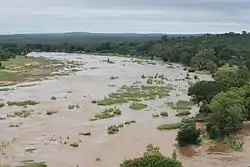
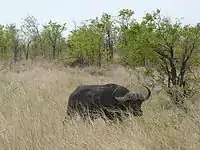
.jpg.webp)
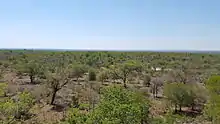
_male_(6001436301).jpg.webp)
_on_the_road_(16509940256)%252C_crop.jpg.webp)